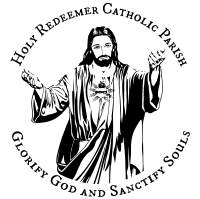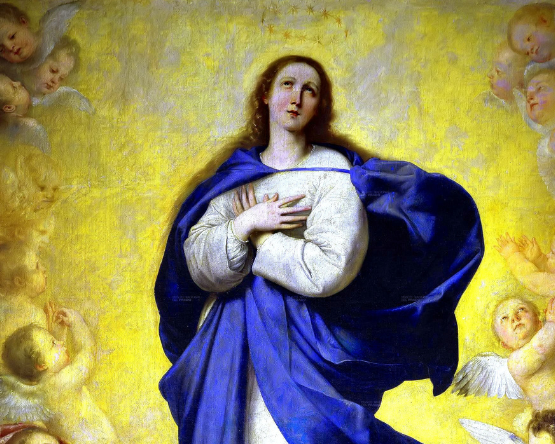The Assumption of the Blessed Virgin Mary ~ Part Two of Two
August 17, 2025
Jesus Christ: Yesterday, Today, and Forever ~
Last Friday, August 15th, we celebrated the Assumption of the Blessed Virgin Mary into heaven. Last Sunday, I ran the first part of this two-part pastor’s column in the bulletin. If you haven’t read the first part yet, you can find it on our website here https://holyredeemervan.org/pastor-columns.
Below is a resumption of an abridged account of the Assumption of the Blessed Virgin Mary by Venerable Blessed Anne Catherine Emmerich (1824 d.) If you look up the address below on the internet you will find much more than I have for you here. The Assumption of the Blessed Virgin Mary is nearly at the end. Enjoy.
In Christ, I Love You,
In Christ, I Love You,
Father Thomas Nathe
Blessed Anne Catherine Emmerich - Continued
https://archive.org/stream/TheLifeOfJesusChristAndBiblicalRevelationsComplete/TheLifeOfJesusChristAndBiblicalRevelations_djvu.txt [Numbers 463-476
[Saint Peter gives the Blessed Virgin Mary the Last Rites] Peter bore the Blessed Sacrament to Mary in the cross hanging on his breast, and John carried in a shallow dish the chalice containing the Most Sacred Blood. Thaddeus now brought forward a little incense basin. Peter first gave the Blessed Virgin the last anointing, just as that Sacrament is administered at the present day. Next, he administered Holy Communion, which she received sitting up without support. Then she sank back again on her pillow, and after the Apostles had offered a short prayer, she received the chalice from John, but not now in so upright a posture.
After Communion, Mary spoke no more. Her countenance, blooming and smiling as in youth, was raised above. I no longer saw the roof of her chamber, and the lamp appeared to be suspended in the open air. A pathway of light arose from Mary up to the heavenly Jerusalem, up to the throne of the Most Holy Trinity. On either side of this pathway, I saw clouds of light out of which gazed angelic faces. Mary raised her arms to the Heavenly Jerusalem. Her body with all its wrappings was floating so high above the couch that I could see under it. A figure of light, also with upraised arms, appeared to issue from Mary. The two choirs of angels united under this figure and soared up with it, as if separating it from the body, which now sank back upon the couch, the hands crossed upon the breast. Many holy souls, among whom I recognized Joseph, Anne, Joachim, John the Baptist, Zachary, and Elizabeth, came to meet her. But up she soared, followed by them, to her Son, whose wounds were flashing light far more brilliant than that which surrounded Him. He received her and placed in her hand a scepter, pointing at the same time over the whole circumference of the earth. At last, I saw, and the sight filled me with joy, a multitude of souls released from Purgatory and soaring up to Heaven, and I received the surety that every year, on the feast of Mary's Assumption, many of her devout clients are freed from Purgatory. The hour of Mary's death was made known to me as that of Noon, at which time also Jesus had died on the cross. Peter and John likewise must have seen the glory of Mary's blessed soul, for their faces were turned upward, but the other Apostles were kneeling bowed to the ground. The body of the Blessed Virgin lay radiant with light upon the couch, the eyes closed, the hands crossed upon the breast. All present knelt, adoring God.
Andrew and Matthias [the apostle who replaced Judas] were busy preparing the place of burial, which was the little grotto that Mary and John had arranged at the end of the Way of the Cross, to represent the Holy Sepulcher of Christ.
The blessed body was prepared by the women for burial. Among them I remember having seen a daughter of Veronica and John Mark's mother. They brought spices and pots of fresh herbs, in order to embalm it according to the Jewish custom.
The whole house had now become like a little chapel in which the Apostles prayed and celebrated the most holy and unbloody Sacrifice. While the women were preparing the holy body for burial, the Apostles prayed, choir and choir, sometimes in the front apartment, sometimes outside the house. The women went about their task most devoutly and reverently, just as had been done when preparing the most Sacred Body of Jesus for burial. The body was of a dry, indescribable whiteness as if shining with light, and of so little weight that, like a mere husk, it could be raised quite easily on the hands. The face was fresh and blooming. The women cut off some locks of hair to keep as relics.
Before the holy body was shrouded in its white garments and enveloped in the winding sheets, Peter celebrated the Unbloody Sacrifice on the altar of the oratory and gave Holy Communion to the other Apostles. After that Peter and John approached the body in their mantles of ceremony. John carried a vessel of oil, with which Peter anointed, in the form of a cross and with accompanying prayers, the forehead, hands, and feet of the holy body, which was afterward entirely enveloped in linens by the women. They placed on the head a wreath of flowers, white, red, and sky-blue, as a symbol of Mary's virginity, and over the face a transparent veil, through which it could be seen encircled by the wreath. The arms and hands were bound crosswise on the breast. Thus prepared, the holy body was laid in a coffin of snow-white wood with a tightly fitting, arched cover, which was fastened down at the head, the foot, and in the middle, with gray straps. The coffin was then laid on a litter. Everything was done with the utmost solemnity, and all were penetrated with deep emotion. The sorrow of the mourners was more human and more openly expressed than at Jesus' burial, at which holy awe and reverence predominated.
When it was time to bear the coffin to the grotto, one half -hour distant, Peter and John raised it from the litter and carried it in their hands to the door of the house, outside of which it was again laid on the litter, which Peter and John then raised upon their shoulders. Six of the Apostles thus carried it in turn. The coffin hung between the bearers as in a cradle, for the poles of the litter were run through leathern straps, or matting. Some of the Apostles walked before the coffin praying, and after it came the women. Lamps, or lanterns on poles, were carried.
Before reaching the grotto, the litter was set down. Four of the Apostles bore the coffin in and placed it in the hollow of the tomb. All went, one by one, into the grotto, where they knelt in prayer before the holy body, honoring it and taking leave of it. Then the tomb was shut in by a wicker screen that extended from the front edge of the tomb to the top of the vaulted wall above.
On the night following the burial, took place the bodily Assumption of the Blessed Virgin into Heaven. I saw on this night several of the Apostles and holy women in the little garden, praying and singing Psalms before the grotto. I saw a broad pathway of light descend from Heaven and rest upon the tomb. In it were circles of glory full of angels, in the midst of whom the resplendent soul of the Blessed Virgin came floating down. Before her went her Divine Son, the marks of His Wounds flashing with light. In the innermost circle, that which surrounded the holy soul of Mary, the angels appeared like the faces of very young children; in the second circle, they were like those of children from six to eight years old; and in the outermost, like the faces of youths, I could clearly distinguish only the face, the rest of the figure consisting of perfectly transparent light. Encircling the head of the Blessed Virgin like a crown was a choir of blessed spirits. I know not what those present saw of all this. But I saw that some gazed up in amazement and adoration, while others cast themselves prostrate in fright upon the earth. These apparitions, becoming more and more distinct as they approached nearer, floated over the grotto, and another pathway of light issued from it and arose to the heavenly Jerusalem. The blessed soul of Mary, floating before Jesus, penetrated through the rock and into the tomb, out of which she again arose radiant with light in her glorified body, and escorted by the entire multitude of celestial spirits, returned in triumph to the heavenly Jerusalem.
Next day … Thomas, Eleasar [a disciple of Thomas’], and John went in [the tomb] and prayed before the coffin. Then John loosened the three straps that bound it, for it rose high enough above the trough-like couch to admit of being opened. They stood the lid of the coffin on one side and, to their intense astonishment, beheld only the empty winding sheets lying like a husk, or shell, and in perfect order. Only over the face was it drawn apart, and over the breast slightly opened. The swathing bands of the arms and hands lay separately, as if gently drawn off, but in perfect order. The Apostles gazed in amazement, their hands raised. John cried out: ''She is no longer here!" The others came in quickly, wept, prayed, looking upward with raised arms, and finally cast themselves on the ground, remembering the radiant cloud of the preceding night. Then rising, they took the winding sheet just as it was, all the grave linens, and the coffin to keep as relics, and returned to the house by the Holy Way, praying and singing Psalms,
When they entered the house, John laid the folded linens on a little flap-table before the altar. Thomas and the others were in prayer, but Peter went a little apart, as if pondering some mystery. After that I saw him celebrating divine service at the altar before Mary's Crucifix, and the Apostles standing in order behind him, praying, and singing.
The Apostles, with tears and embraces, took leave of one another after they had once more celebrated solemn service in Mary's house. An Apostle or disciple often returned at different times to pray there. I saw also that here and there, out of devotion and in reverence for the Blessed Virgin, churches were built by the Faithful in the same style as her house, and that her Way of the Cross and her tomb were for a long time devoutly visited by the Christians.
In 1951 Pope Pius XII, the pope who defined the dogma of the Blessed Virgin Mary's Assumption into Heaven, removed a text from the Breviary which referred to the tradition of Jerusalem. He also elevated the Tomb of St. John, the Church of St. Mary and the House of the Virgin to the status of Holy Places, a privilege later made permanent by Pope John XXIII — thus making of Ephesus, as it were, a new Holy City for the modern world. Since then, it has been visited by increasing numbers of pilgrims from all over the world, including Pope Paul VI in1967, Pope John Paul II in 1979, and Pope Benedict XVI in 2006.


